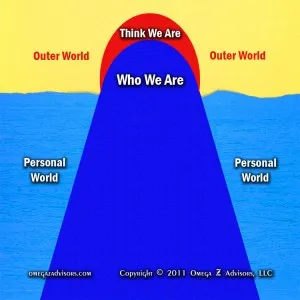“Who We Are” is Different From “Who We Think We Are”
As I had mentioned in a previous post, who we are (WWA) is different from who we think we are (TWA), an important concept behind intuitive approaches. It can explain many of the contradictions we observe in what people say and do and explain the problems with self-report personality assessments. Awareness of TWA-WWA will help us minimize erroneous conclusions when predicting human behavior.
Whereas TWA resides in our conscious, WWA resides primarily in our subconscious and is much greater. Consequently, TWA only represents the tip of the iceberg in terms of our potential. We often only discover aspects of WWA when we are challenged to learn or face a crisis.
On the downside, TWA holds much of what others (parents, friends, educators, community, etc.) teach us or condition us to believe about the world and us. Consequently, TWA can impede us from doing what we really want to do by causing us to ignore, deny, discount or suppress it. Pragmatically, the TWA-WWA difference will often account for the many errors we find in all kinds of surveys (quality service, market research, etc.). On an interpersonal level, it will account for much of the hypocrisy we see in others.
We learn WWA by listening to what we say, observing what we do and interpreting what we think; we can do the same with others. It works because we cannot consciously control every aspect of what we say, do and think. There are gaps; our subconscious fills them. It’s this “filler” that provides clues to WWA; it’s a matter of learning to read these clues. Many times this can only be done through direct interaction with the person so we can make ancillary observations; something surveys often don’t do.


